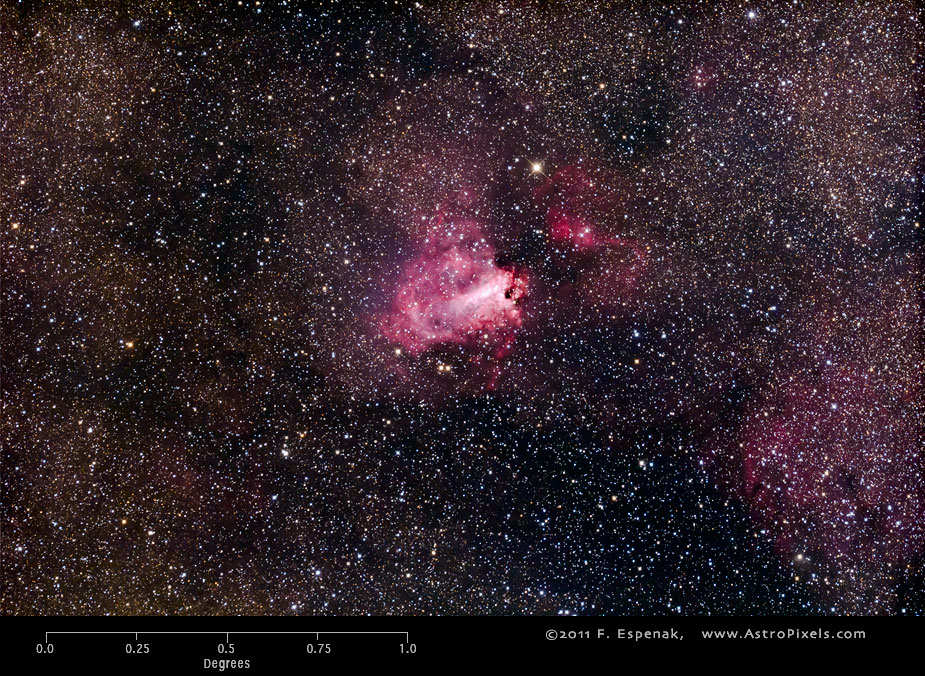
M17 - Omega Nebula
Messier 17 or M17 (also designated NGC 6618) is a nebula and star cluster in the constellation Sagittarius. It has an apparent visual magnitude of 7 and its angular diameter is 11 arc-minutes. M17 lies at an estimated distance of 5000 light years. The Equinox 2000 coordinates are RA= 18h 20.8m, Dec= -16° 11´ which makes M17 best seen during the summer. The Messier Summer Star Chart shows the position of all Messier objects visible during that season. As one of the more famous objects in the Messier Catalog, it is commonly known as the Omega? Swan? or Checkmark Nebula.
The image above shows the uncropped view of M17 through the Takahashi E-180 Astrograph (North is up). A 2x enlargement of this image appears to the right.
In spite of its inclusion in the Messier Catalog, this nebula and star cluster were actually discovered by J-P. de Chéseaux in 1746. The Omega Nebula is a region of active star formation. Its glowing hydrogen gas is due to excitation from ultraviolet radiation emitted by hot young stars embedded in the nebula. According to Kharchenko et al. (2005), the distance of M17 is 5910 light years and its diameter is 10 light years. It contains 2200 stars and its estimated age is 1 million years.
For more information, see the Messier Catalog as well as specific entries for M17 in Wikipedia and SEDS.
Messier's Description of M17
June 3, 1764
`A train of light without stars, of 5 or 6 minutes in extent, in the shape of a spindle, and a little like that in Andromeda's belt [M31] but of a very faint light; there are two telescopic stars nearby and placed parallel to the equator. In a good sky one observes this nebula very well in an simple refractor of 3.5 feet. Reviewed on March 22, 1781.' (diam. 5')
Technical Details
- Object: M17 - Omega Nebula
- Other Names: NGC 6618, Omega, Swan, or Checkmark Nebula
- Object Type: nebula and star cluster
- Object Data: Apparent Magnitude = 7, Angular Size = 11 arc-minutes
- Object Position (Equinox 2000): RA= 18h 20.8m, Dec= -16° 11´, Constellation = Sagittarius
- Date/Time: 2011 May 06 at 10:19 UTC
- Location: Bifrost Astronomical Observatory, Portal, AZ
- Mount: Astro-Physics 1200GTO
- Telescope: Takahashi Epsilon 180 Hyperbolic Astrograph
- Camera: Canon EOS 550D (Rebel T2i) (modified with a Baader UV/IR filter)
- Field of View: 1.70° x 2.56° at 1.7 arc-sec/pixel (web version: 10.0 arc-sec/pixel)
- Exposure: 4 x 300s, f/2.8, ISO 800
- File Name: M17-01w.jpg
- Processing (Adobe Camera Raw): Graduated Filter, Vignetting Correction, Noise Reduction, White Balance, Curves
- Processing (Photoshop CS5): Average Images, Curves, Noise Reduction
- Original Image Size: 3454 × 5179 pixels (17.9 MP); 11.5" x 17.3" @ 300 dpi
- Rights: Copyright 2011 by Fred Espenak. All Rights Reserved. See: Image Licensing.
